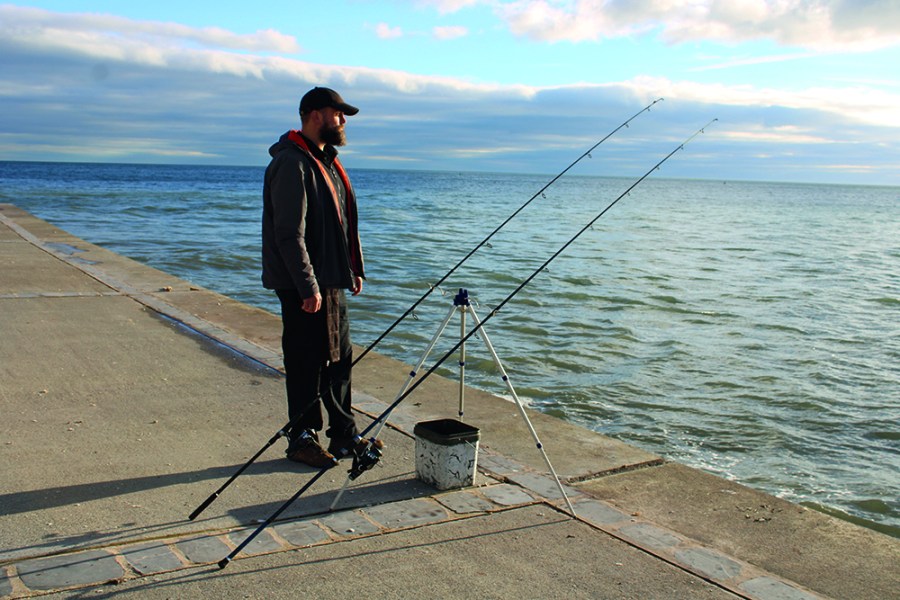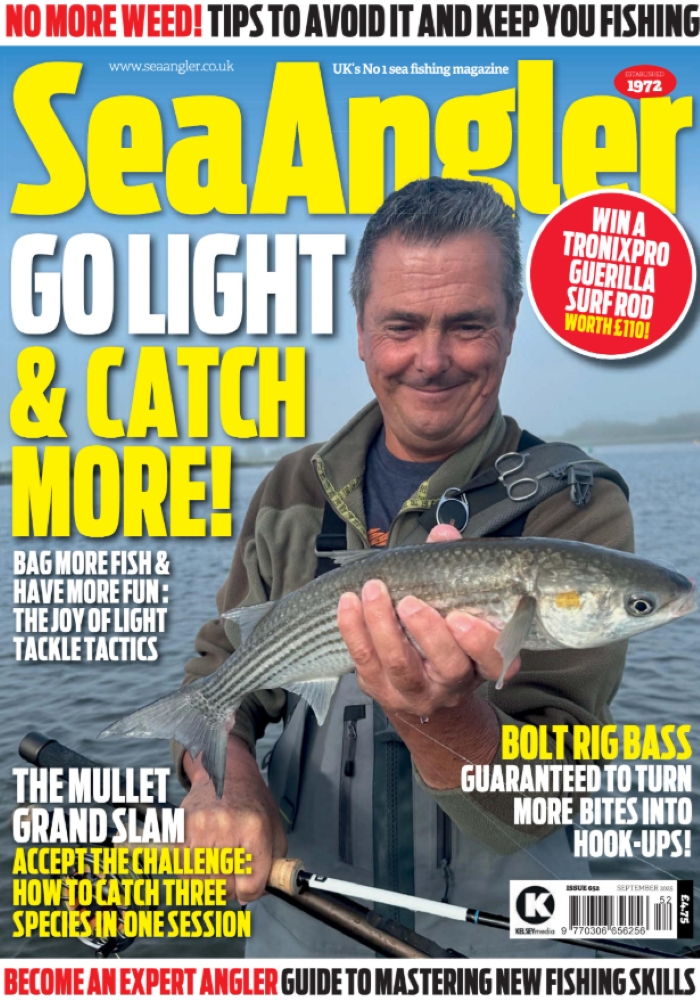Sea fishing innovator Lindsey Green looks into the origins of the paternoster, and provides a step-by-step guide to how to tie his new luminous anti-tangle rig – the T-Boom
The paternoster is one of the most popular sea angling rigs – versatile and usable in most situations. Here sea angling innovator Lindsay Green looks into the origins of the rig and provides a step by step guide to tying his luminous anti tangle rig – the T Boom.
When I was young, I was first introduced to paternoster tackle when I was part of an interclub junior quiz team. I was told that it got its name – literally (in Latin) ‘Our Father’ from the Oratio Dominica (the Lord’s Prayer) – from Cistercian monks who used to breed carp in stew ponds for eating. The monks were forbidden meat on a Friday so the carp in their stew ponds became the next best thing on the menu. Supposedly, they used an early form of the paternoster rig to catch them usually, and this made me chuckle, with wooden poles to which horsehair fibres were attached. Being young, I went along with this – it seemed logical after all and I had no reason to question it – though it now seems likely that this is yet another example of folklore that has grown up around the original form of the tackle.
In some quarters it is associated with St Peter catching a fish in the New Testament, presumably with a paternoster rig. He drew a coin from its mouth and, since there are thumb-like marks on the body of the John Dory, many people associate this species with the legend. Other people draw links between fishing close to Paternoster Row in London, where monks used to process to St Pauls Cathedral, while others drew connections with rosaries. These were widespread in ancient communities and had numerous beads above a larger cross at the bottom. Since the tackle was described as having a weight at the bottom while grooved beads, attached to hooks via traces of horsehair, gut or even silk, were placed in positions above, this seems likely to be the most logical contender. Whether this is accurate or simply a believable theory is open to debate.
In truth, I am not sure that anyone knows the origins of the tackle with absolute certainty. It is mentioned in Izaak Walton’s 1653 edition of The Compleat Angler but it was likely in common use already. Indeed, one of the few things that we can say for certain is that the principle of fishing hooks above the weight was established centuries ago.
Nowadays, the tackle has evolved into numerous forms. There are clipped down versions for long distance casting, sliding paternosters, combination paternoster legers, flapper rigs where distance is not necessary, rigs for bream and fishing over reefs from boats, floating versions for tackling shoaling fish like mackerel, pollack and scad, and all manner of different takes on the same theme. Despite its popularity, however, it lacks the sophistication of modern, clipped-down rigs, pulley rigs, up-and-overs, legers and many more. So why has its popularity endured?
The basic reason for its success is that it works, to which several factors contribute: with the traces above the weight, there is less chance of the hooks becoming entangled in weed, which has given rise to the rotten bottom tackle and even, if you want to be technical, the drop shot rig; You can fish multiple traces: there is less likelihood of tangles, especially if you are careful with the length and breaking strains of the hook lengths; If you are fishing close in from a height, you can even raise the hooks off the seabed to attract the attention of passing fish – be careful with this one though: If you are casting off a beach, anything further than 65 yards from the shore will be resting flat on the sand, presenting the baits horizontally, not vertically.
All in all, there are several species which are quite happy to take baits fished paternoster tackle, including scratching species like whiting, pouting, rockling and dogfish, float-fished species such as scad, mackerel and pollack but also harder fighting fish such as bream. Nor is this list exhaustive since numerous others are taken on it every year.
BASIC
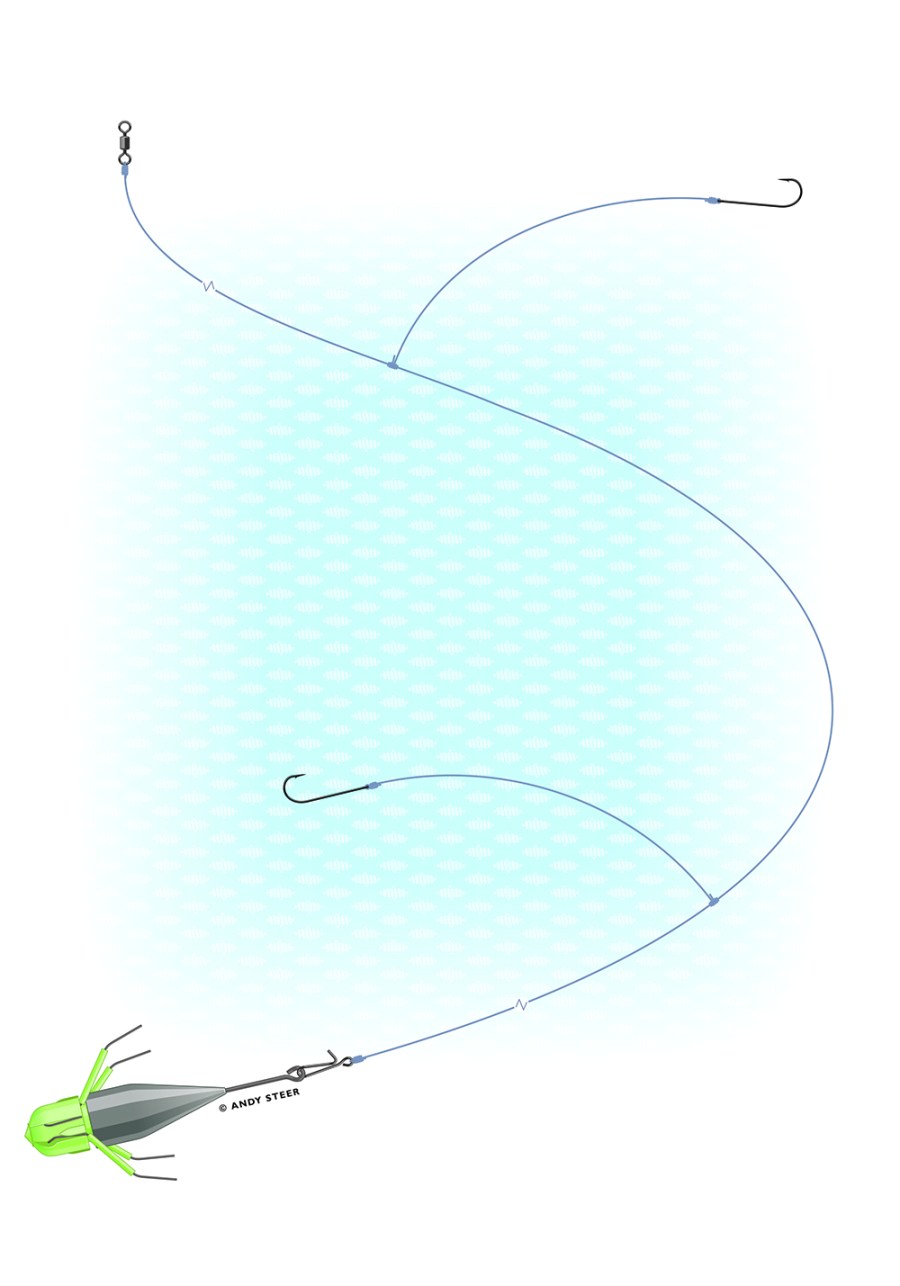
At its most basic level, you can tie a couple of widely spaced dropper loops in leader material, cut them near the knot and then tie on hooks before attaching a weight to the bottom. It is simple, catches a number of fish, and is cheap to make. Unfortunately, the species to which it is most attractive, at least down my way, like fish baits, particularly in the winter months where fishing, especially in February and March, can be hard. The strips twirl, causing the traces to spin and twist, ruining presentation in the process and requiring that a new tackle be made as soon as possible. Since the traces are as thick as the leader line, there is also some concern that bait presentation is crude and the tackle off-putting to some species which require more finesse in bait presentation.
ADVANCES IN DESIGN
Recently, there have been advances at the simple end of the tackle, moving away from sophisticated, tackle-heavy rigs. The T-knot improved the trace’s ability to be held away from the mainline but, since the traces can droop, was pretty good but unfortunately not perfect. There is still a bit of tangling and also, without swivels, the problems with fish baits and twisting remained.
To get around this I introduced a method of sleeving the T-knots with luminous tubing and, by pulling back on the rubber, exposed enough of the loop to secure a swivel. You do this by passing the loop through one eye of the swivel, over the top of the other and down the back of the swivel to lock it in place. I then released the luminous tubing and pulled it forward so that it sheathed one side of the swivel while allowing the other eye to do its work: spinning so that the fish strips on the hook did not ruin the trace. It works pretty well although its efficiency lessens the longer the T-Knot is. Shorter ones work better.
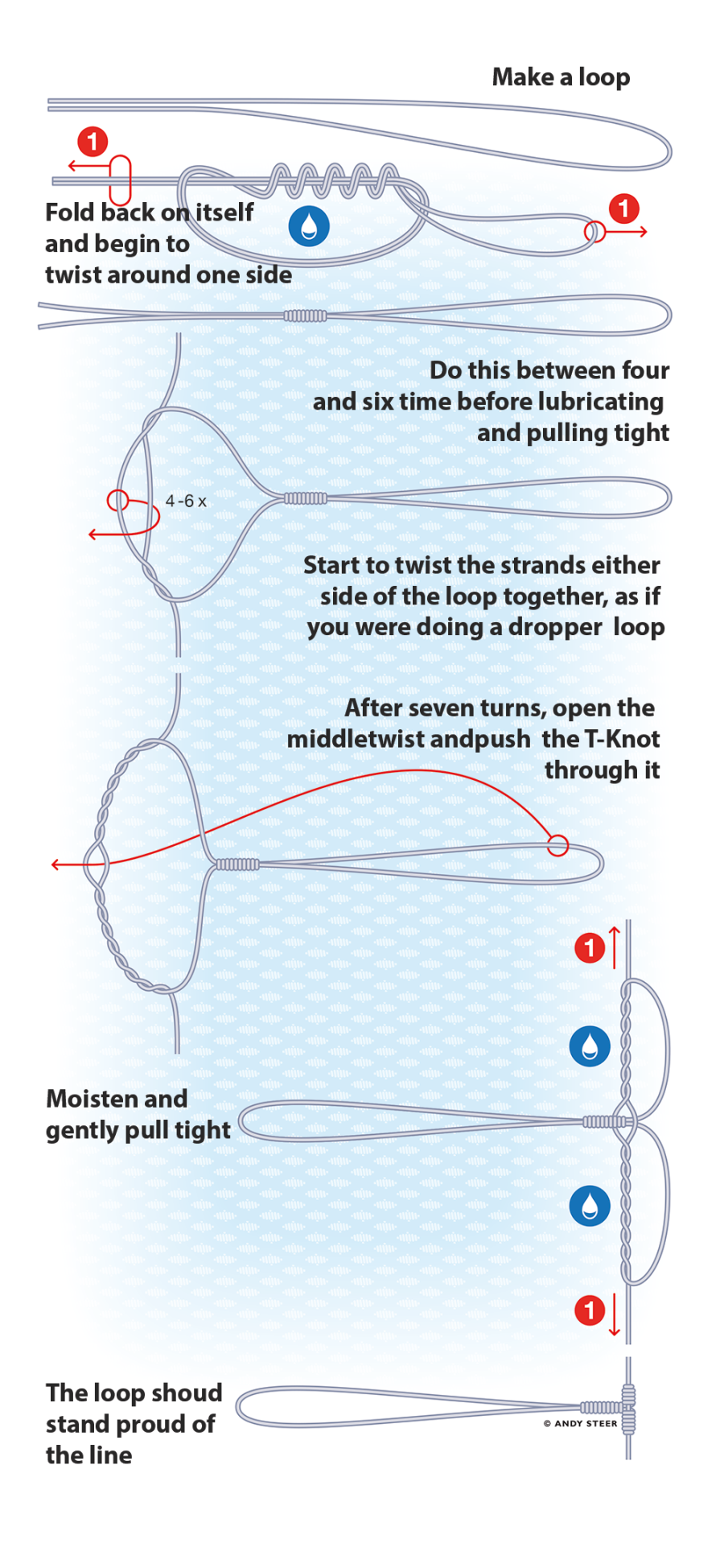
The first time that I used the swivelled T-knot it worked very well. However, what was particularly interesting was that I was catching on a night where other anglers were struggling. At one point I had five small dogfish and several whiting while the other anglers had not caught anything at all. Since I was using an ultraviolet torch to help the luminous tubing glow, I began to wonder if this was making a difference. I gave the angler next to me, who had not had a bite, one of my made-up rigs. Now it could have been coincidence but, within seconds of casting, he proceeded to catch a dogfish and, after that, carried on catching.
Since then, I have used the rig on several occasions to see what happened. I took a friend of mine to a mark where there were several anglers and, almost from the beginning, she started catching fish, mostly whiting and dogfish, of which she had five. Of the other four anglers there, no-one else had a doggie and very few whiting came up while my friend was catching them consistently. I have repeated the experiment several times since with the same result. It seems to me that there is something about adding a luminous component to the rig after all.
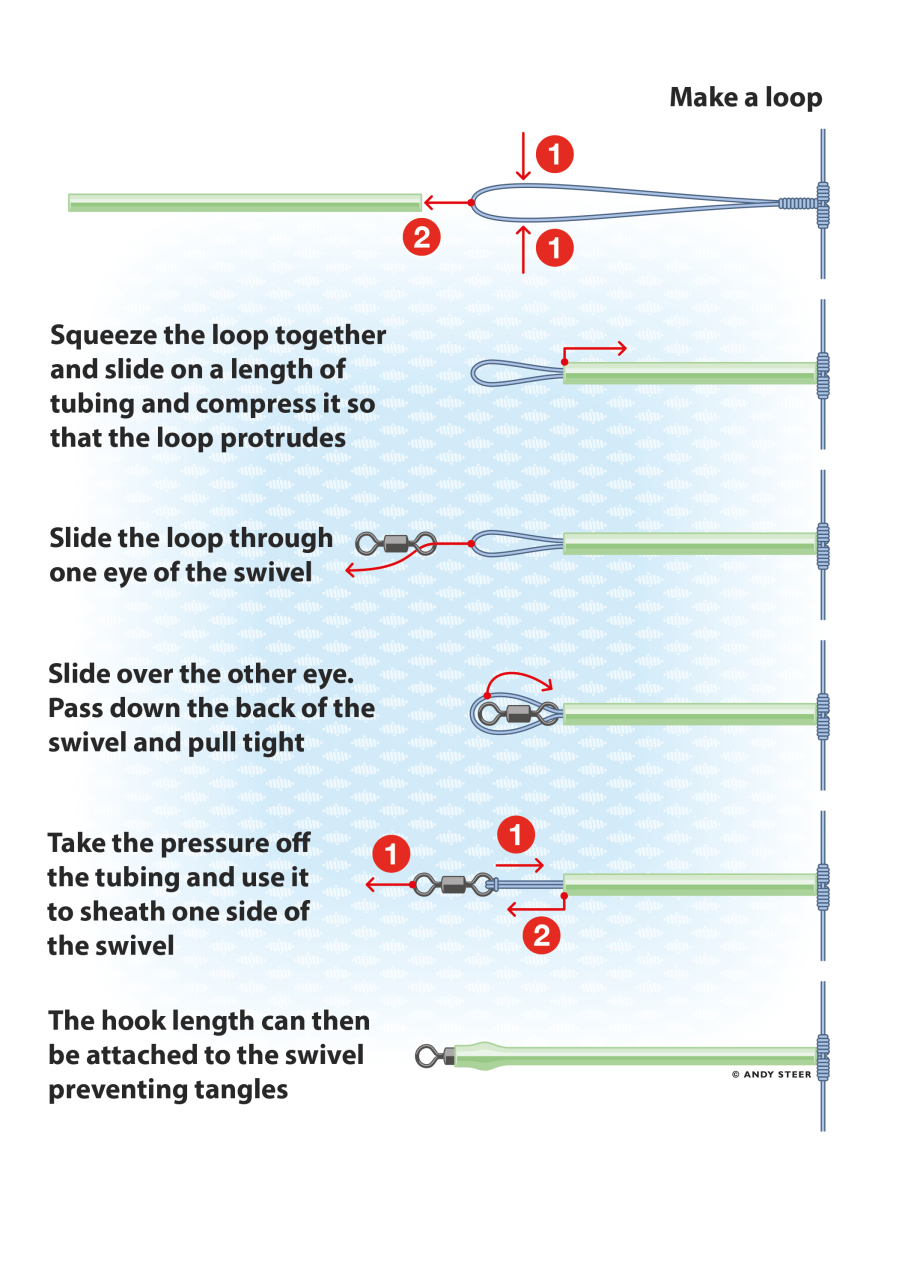
Overall, I have been very pleased with the rig’s performance but I am not the sort of person to think ‘good enough’ and leave it at that. I have always had a nagging ‘what if’ quirk to my personality. so, of course, I took it further!
The T-BOOM
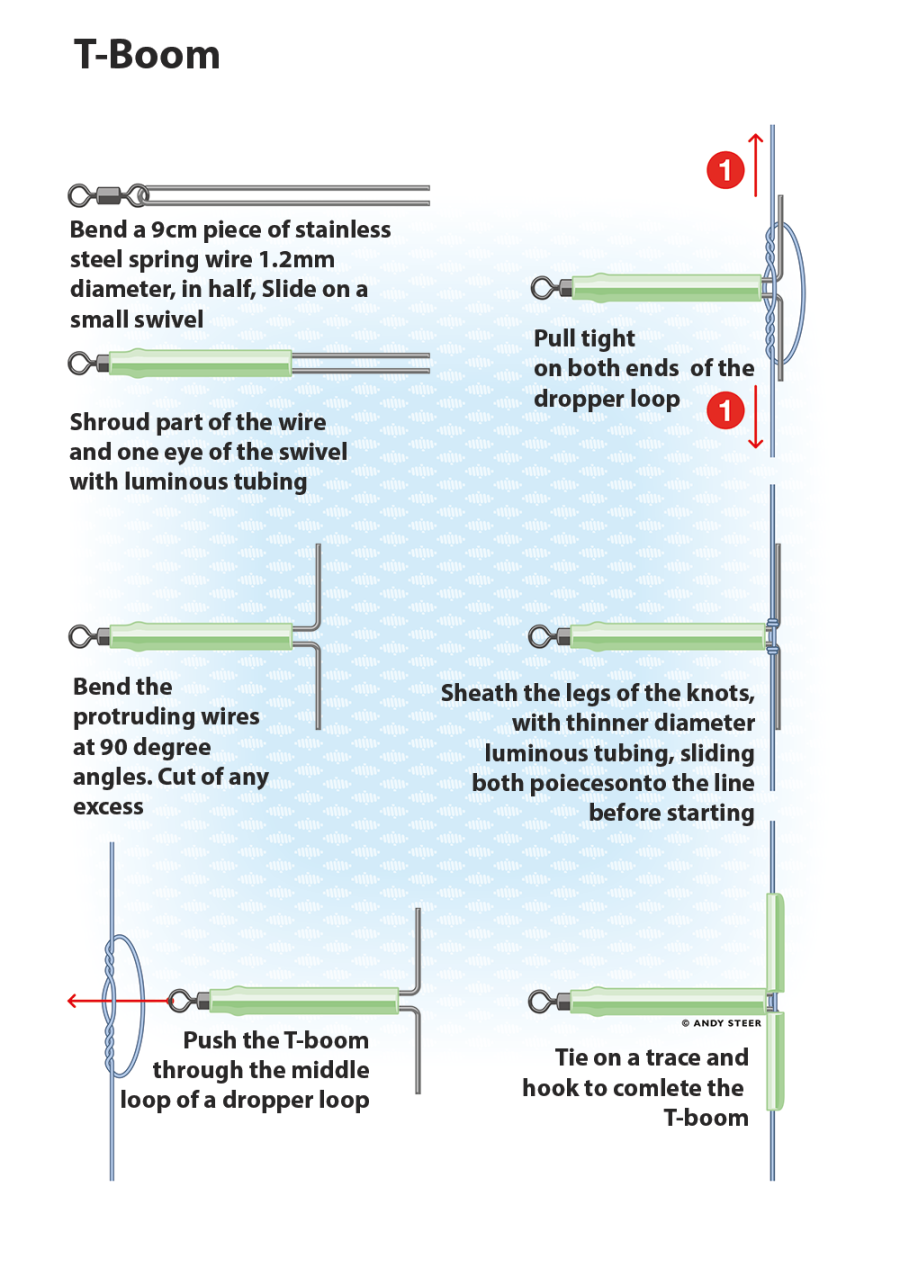
My latest development of the paternoster was prompted by the T-Knot and sleeving method that I have described. It occurred to me that a small boom, nowhere near as big as those produced commercially, could be made out of strong materials, fitted with a swivel and, to increase its efficiency, sheathed in luminous tubing. It could hold out the traces properly, be very difficult to tangle and add in the luminous materials to pull in the fish when bites were scarce. It would also work perfectly with fish strips, with the little booms sticking out further than a swivel slid on the main line and, consequently, less prone to tangles.
Naturally, being me, I immediately set out experimenting, looking for the simplest way to achieve a creditable result. My friends joke that I use wire for everything – I don’t, but, to be honest, everything has to be made out of something and stainless steel spring wire is perfect for any number of things to do with sea fishing. Accordingly, I took nine centimetres of 1.2 mm spring wire, folded it in half, hairpin fashion, slid on a small swivel and sheathed half of the swivel and the end of the loop in luminous tubing. I folded one of the protruding wires up and the other down.
Of course, I had to attach the boom – I call it the T-Boom – to the line. To me, the simplest way of doing this was to push the horizontal, sheathed part, of the boom through the middle loop of a dropper loop, pull tight and then use a smaller diameter luminous tubing to sheath both of the vertical legs. This way, any pull from a taking fish would have no chance whatsoever to pull the boom free from the line. The illustration shows the rig clearly but the real question is, will it work? My feeling is that this new version will be even better!

